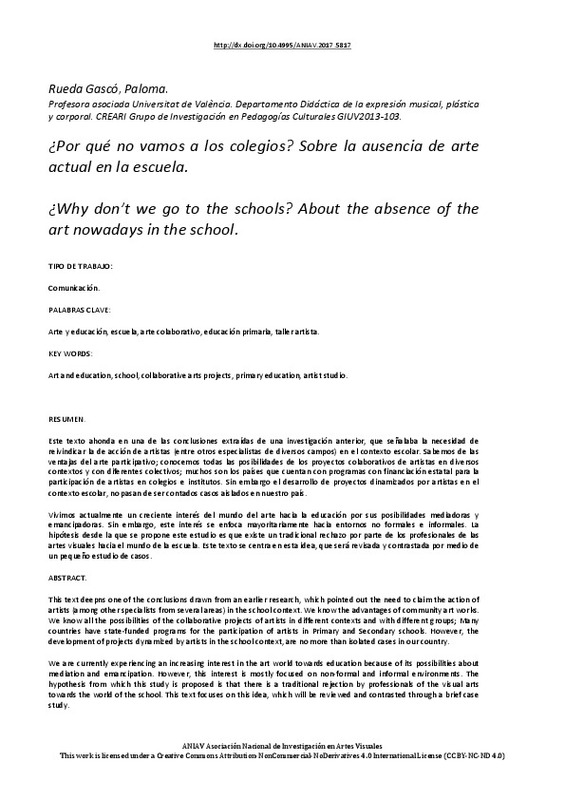JavaScript is disabled for your browser. Some features of this site may not work without it.
Buscar en RiuNet
Listar
Mi cuenta
Estadísticas
Ayuda RiuNet
Admin. UPV
¿Por qué no vamos a los colegios? Sobre la ausencia de arte actual en la escuela
Mostrar el registro sencillo del ítem
Ficheros en el ítem
| dc.contributor.author | Rueda Gascó, Paloma
|
es_ES |
| dc.date.accessioned | 2018-09-10T08:31:54Z | |
| dc.date.available | 2018-09-10T08:31:54Z | |
| dc.date.issued | 2017-10-23 | |
| dc.identifier.isbn | 9788490485736 | |
| dc.identifier.uri | http://hdl.handle.net/10251/106840 | |
| dc.description.abstract | [EN] This text deepns one of the conclusions drawn from an earlier research, which pointed out the need to claim the action of artists (among other specialists from several areas) in the school context. We know the advantages of community art works. We know all the possibilities of the collaborative projects of artists in different contexts and with different groups; Many countries have statedfunded programs for the participation of artists in Primary and Secondary schools. However, the development of projects dynamized by artists in the school context, are no more than isolated cases in our country. We are currently experiencing an increasing interest in the art world towards education because of its possibilities about mediation and emancipation. However, this interest is mostly focused on nondformal and informal environments. The hypothesis from which this study is proposed is that there is a traditional rejection by professionals of the visual arts towards the world of the school. This text focuses on this idea, which will be reviewed and contrasted through a brief case study. | es_ES |
| dc.description.abstract | [ES] Este texto ahonda en una de las conclusiones extraídas de una investigación anterior, que señalaba la necesidad de reivindicar la de acción de artistas (entre otros especialistas de diversos campos) en el contexto escolar. Sabemos de las ventajas del arte participativo; conocemos todas las posibilidades de los proyectos colaborativos de artistas en diversos contextos y con diferentes colectivos; muchos son los países que cuentan con programas con financiación estatal para la participación de artistas en colegios e institutos. Sin embargo el desarrollo de proyectos dinamizados por artistas en el contexto escolar, no pasan de ser contados casos aislados en nuestro país. Vivimos actualmente un creciente interés del mundo del arte hacia la educación por sus posibilidades mediadoras y emancipadoras. Sin embargo, este interés se enfoca mayoritariamente hacia entornos no formales e informales. La hipótesis desde la que se propone este estudio es que existe un tradicional rechazo por parte de los profesionales de las artes visuales hacia el mundo de la escuela. Este texto se centra en esta idea, que será revisada y contrastada por medio de un pequeño estudio de casos. | es_ES |
| dc.format.extent | 6 | es_ES |
| dc.language | Español | es_ES |
| dc.publisher | Editorial Universitat Politècnica de València | es_ES |
| dc.relation.ispartof | Glocal [codificar, mediar, transformar, vivir] III Congreso Internacional de Investigación en Artes Visuales | es_ES |
| dc.rights | Reconocimiento - No comercial - Sin obra derivada (by-nc-nd) | es_ES |
| dc.subject | Arte y educación | es_ES |
| dc.subject | Escuela | es_ES |
| dc.subject | Arte colaborativo | es_ES |
| dc.subject | Educación primaria | es_ES |
| dc.subject | Taller artista | es_ES |
| dc.subject | Art and education | es_ES |
| dc.subject | School | es_ES |
| dc.subject | Collaborative arts projects | es_ES |
| dc.subject | Primary education | es_ES |
| dc.subject | Artist studio | es_ES |
| dc.title | ¿Por qué no vamos a los colegios? Sobre la ausencia de arte actual en la escuela | es_ES |
| dc.title.alternative | Why don't we go to the schools? About the absence of the art nowadays in the school | es_ES |
| dc.type | Capítulo de libro | es_ES |
| dc.type | Comunicación en congreso | es_ES |
| dc.identifier.doi | 10.4995/ANIAV.2017.5817 | |
| dc.rights.accessRights | Abierto | es_ES |
| dc.description.bibliographicCitation | Rueda Gascó, P. (2017). ¿Por qué no vamos a los colegios? Sobre la ausencia de arte actual en la escuela. En Glocal [codificar, mediar, transformar, vivir] III Congreso Internacional de Investigación en Artes Visuales. Editorial Universitat Politècnica de València. 609-914. https://doi.org/10.4995/ANIAV.2017.5817 | es_ES |
| dc.description.accrualMethod | OCS | es_ES |
| dc.relation.conferencename | III Congreso Internacional de Investigación en Artes Visuales :: ANIAV 2017 :: GLOCAL | es_ES |
| dc.relation.conferencedate | Julio 06-07,2017 | es_ES |
| dc.relation.conferenceplace | Valencia, Spain | es_ES |
| dc.relation.publisherversion | http://ocs.editorial.upv.es/index.php/ANIAV/ANIAV2017/paper/view/5817 | es_ES |
| dc.description.upvformatpinicio | 609 | es_ES |
| dc.description.upvformatpfin | 914 | es_ES |
| dc.type.version | info:eu-repo/semantics/publishedVersion | es_ES |
| dc.relation.pasarela | OCS\5817 | es_ES |








